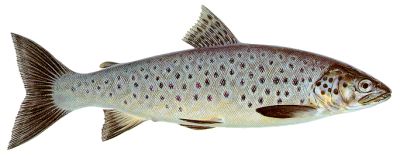
The Sonaghen Trout

|
A sonaghen trout from Lough
Melvin. The proportionally large tail fin and streamlined figure
enable the sonaghen to compete within the feeding shoal. |
Early scientists called the sonaghen Salmo nigripinnis, after one of its most distinctive features. The Latin name – nigri, black; pinnis, fins - is a direct translation of its alternative common name, the black-finned trout. Today the variety is found only in Ireland's Lough Melvin, but at one time, it was also believed to occur in some Welsh mountain lakes, where it was referred to as the Welsh black-finned trout.
Dr Günter, the 19th century fish biologist, gave Llyn Beguilin in Merionethshire and Llyn Gadr on the slopes of Cader Idris as two such lakes that were inhabited by this form. However, it seems that these Welsh fish are highly variable and are better considered ordinary lake brown trout that, because of the nature of their habitat, have a dark pigmentation.
The sonaghen is a quite distinct trout in both appearance and behaviour. It is a relatively small fish, averaging less than ten inches in length and well under a pound in weight. In colour it is superficially very plain: steel-blue, darker on the back, with a few distinct black spots and a very few dull red or orange ones. The black fins are eye-catching for they are not simply dark or blackish, they are truly black. Two other features of the sonaghen that a close examination reveals are a relatively large head and mouth, and a very large caudal (or tail) fin. These give us a clue as to the lake life of the fish.
Sonaghen differ from other forms of brown trout in that they spend their entire lives, outside the spawning period, in very deep water. In the depths of the lough they feed on shoals of zooplankton: tiny crustaceans that in turn feed on immense clouds of microscopic plant plankton. The shoals of zooplankton drift around the lake, so the sonaghen must follow them. And because their prey is so tiny they do not pick them off individually. Instead they swim along, with mouths open, filtering them from the water by the thousand. Hence they have evolved a large mouth as a water-strainer and a large caudal fin to propel them on their meanderings around the lough.
There are periods of the year when the populations of zooplankton are too small to sustain the sonaghen, notably from autumn through to late spring. Then they will feed on insects that have been blown on to the lake or drifted from the shallow margins into the deeps. But, save for the brief spawning season in early winter, they appear not to leave the deep water. That is their niche, and they stick to it. Even though they share Lough Melvin with the gillaroo, the two forms rarely meet, for they are ecological opposites. It is thought that the ancestor of the sonaghen was a sea-going trout that colonised the lake, via the Drowes River, from the Atlantic following the retreat of the arctic ice some 10,000 years ago. This colonisation was separate from those of other sea-going trout which gave rise to the gillaroo, ferox and Atlantic sea trout that also are still present in the lough. As a Queen's University of Belfast study has shown, each of these has remained genetically isolated; and each has its own niche in the lough system.